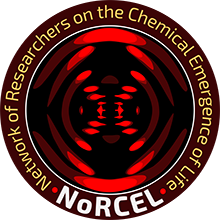The “RNA World” proposes that early in evolution RNA could have served both as the carrier of genetic information and as a catalyst. Later in evolution, these RNA functions were gradually replaced by DNA and enzymatic proteins. Arguably, the greatest limitation to exploring this hypothesis is the lack of a true RNA replicase: a processive, trans-acting RNA dependent RNA polymerase ribozyme capable of mediating general replication of RNA. Derived from the Class I ligase ribozyme, we have selected a processive polymerase ribozyme with an RNA clamp domain that mimics many of the mechanisms of modern protein DNA-dependent polymerases.
The selected ribozyme has the following features: 1. The polymerase clamp domain forms an “open” complex when activated with a sigma-like RNA. 2. This “open” complex then searches for a specific RNA promoter. When found, the sigma-like RNA is displaced from the clamp onto the template, triggering a structural rearrangement to a “closed” complex entrained on the RNA template. 3. The displaced sigma-like RNA now serves as a primer, allowing the clamped polymerase to extend a broad range of templates in a processive fashion. This Clamping Polymerase (CP) ribozyme was isolated from a high diversity pool using a range of new in vitro selective strategies. The CP ribozyme has two distinct predicted secondary structures that suggest how the polymerase first binds a sigma-like RNA to find a promoter and then in a second step associates with an RNA template via the formation of a topological clamp.
As an additional feature, this polymerase can synthesize part of its own sigma-like RNA when in the “open” form. This allows part of the polymerase sequence to be encoded into the RNA promoter motif, providing a mechanism early in the evolution of life for a molecular sense of ‘self’ to rapidly evolve. The CP ribozyme demonstrates how the important concepts of promoter recognition, processive polymerization, and self-recognition could have rapidly evolved in a primordial “RNA World”.


